THE LAPEL DAGGER of WORLD WAR TWO
By
DENNIS MARTIN
The Second World War was a pinnacle of edged-weapon development. Numerous fighting knives, killing daggers, utility knives and clandestine weapons were designed, produced and issued. In this article we will discuss the Lapel Dagger, and it’s smaller version the Thumb Dagger, which were designed as a “last ditch” weapon. Numerous types of blade, handle and sheath abound. The following notes come from our presentation of some of the interesting methods of employment of this weapon. At the First International Combatives Seminar.
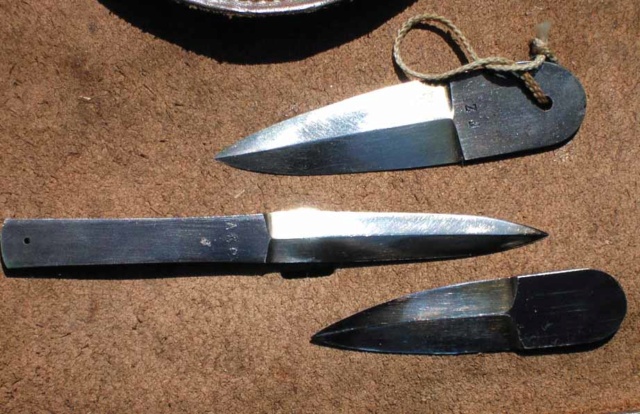
HISTORY OF THE LAPEL DAGGER
Because of the doubts and disinformation surrounding the Lapel Dagger, I’ve put down my thoughts on it’s origin.
A prime source of information was the research of Terry Haglund, a noted edged-weapon collector and researcher. Terry ran a knife shop, and also had stalls at militaria fairs. Here he met and talked to numerous veterans of WW-2, many who had first hand experience of training with Fairbairn and Sykes. Terry never accepted anything at face value, and always tried to cross-check sources, to get at least two confirmations of any story or event. Over the years he built up a very detailed picture. I met Terry once a week for coffee, until his illness and death, and was able to gather much of this material. He very kindly gave me the instructors notes that fleshed out the text of All in Fighting, for example.
Terry was of the opinion that EA Sykes was the specialist in arcane killing methods, and the designer of many of the clandestine weapons, such as Thumb/lapel daggers, brochettes etc
Let’s consider some of the proposed origins of the Lapel Dagger.
Proposition 1] Created by a cutlery company.
Several researchers have proposed that a British knife maker came up with the dagger. For example Dr Windrum wrote “Originally conceived by Mappin & Webb, it was agreed to at a meeting on December 1942 by Major Sinclair at the War Office.”[1]
Why would a cutlery company come up with the design for a clandestine weapon for a highly secret agency? The normal procedure would be for an agency, or, military unit to generate a proposal for manufacture, rather than the other way round.
“Although SOE devised and developed its own equipment, orders were usually placed with outside contractors for its manufacture” [2]
Proposition 2] Created by Fairbairn and Sykes.
According to Lt Colonel LJC Wood “I helped to get Fairbairn and Sykes over to us from the Shanghai Riot Police” [2]
Colonel Wood was the CO of Station 12, Aston House, the top secret SOE research and training establishment. He goes on “Fairbairn and Sykes were guests at Aston for some time, using it as a centre for unarmed combat and pistol shooting instruction; and helping with the design and production of some “toys” for the Resistance”
Now we come to the crux….” Fairbairn and Sykes also invented the thumb or crotch knife”
The sheaths for these were made by local Aston cobbler Arthur Acres.
In my opinion that is the definitive version.
Note, Fairbairn and Sykes arrived in England in late 1940. Fairbairn left in spring 1942, so that meeting with Mappin & Webb in December 1942 was much later than the Aston design phase. What happened was that designs created at Aston [and other SOE establishments] would be sent to industry for mass production, under War Office contract; the WO being the contact point between industry and the secret units.
Proposition 3] E.A. Sykes
To narrow down the design origin further, taking Terry Haglund’s views about the position of E.A. Sykes as the fundi on assassination methods and clandestine weapons, the evidence for him being the actual designer is as follows.
In an article Leroy Thompson says, “I have in my collection E.A. Sykes’ Lapel Dagger, which bears his chop, and which he carried in a carved ivory case” [3]. Now Mr Thompson does not claim Shanghai lineage for this knife but the ivory case, as well as the Chinese ideogram [chop] do suggest it strongly.
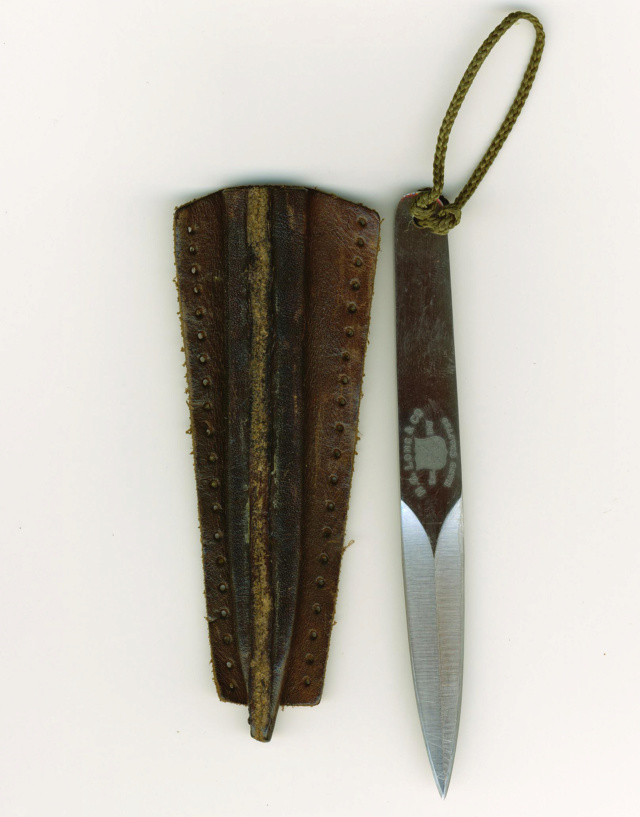
Finally, in his Service Resume, written by Fairbairn at the end of his attachment to OSS, he writes, “ I have established the use of several weapons used especially for close-contact fighting. Some of these weapons are known as the Fairbairn-Sykes Fighting Knife; The Cosh Spring Baton, the Spike Necklace, the Fair Sword and the Fairbairn-Millerson fighting knife” [4]. No mention of Lapel or Thumb daggers, and I’m sure that if he had designed them they would be on the list.
To sum up, E.A. Sykes designed the clandestine weapons and should be recognized as the wartime expert on arcane Silent Killing methods.
OPERATIONAL CONSIDERATIONSThe Lapel Dagger was designed for SOE Agents, then adopted by other prone-to-capture units, such as the Commandos and the SAS. The OSS also issued their versions.
A prime consideration for the agent was the risk of compromise being found in the possession of such a signature device, versus the survival benefits of having the knife available. This was an individual decision based on locale, agent cover identity, clothing etc. In general, agents avoided items which were considered “giveaways”
n general, agents avoided items which were considered “giveaways”, although SOE hero- agent FF Yeo Thomas [Codename White Rabbit] carried a knuckleduster and a folding knife.
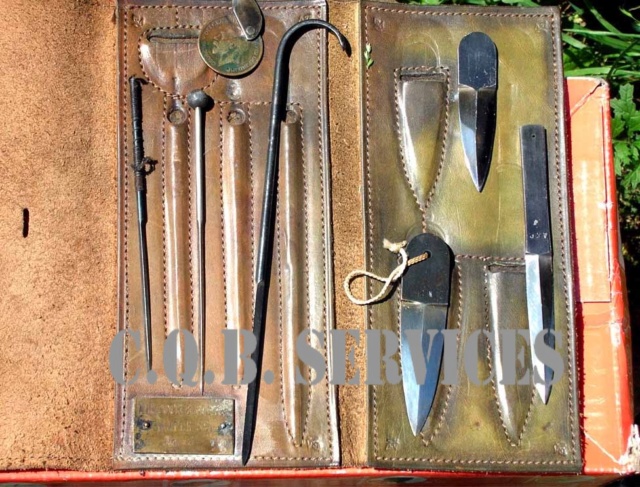
[An extremely rare "Instructors' Kit" which packed Lapel/Thumb/Sleeve daggers, brochettes, coin-blades etc in a leather wallet. The instructor could display this to his various training classes. Collection of Nick Engelen]
CARRIAGE and ACCESS
The sheath could be stitched behind the collar/lapel- hence the name- or located in various other strategic locations, such as inside a pocket, the waistband, the boot.
Access was ideally done in advance, or by stealth (for example while being subdued/beaten). However in an emergency a quick “draw” could take the enemy by surprise.
OPTIONS
1] ESCAPE
At a security check, if the agent thought he was likely to be arrested the idea was to break contact by sudden attack on the nearest guard. The first consideration was available cover and concealment. It did little good to attack one enemy, only to be shot by the others. Trees, bush or crowds would allow escape once contact was broken.
The prime technique was to surreptitiously access the blade, looping the cord around the index finger, and gripping the weapon between thumb/index finger. The following techniques were available.
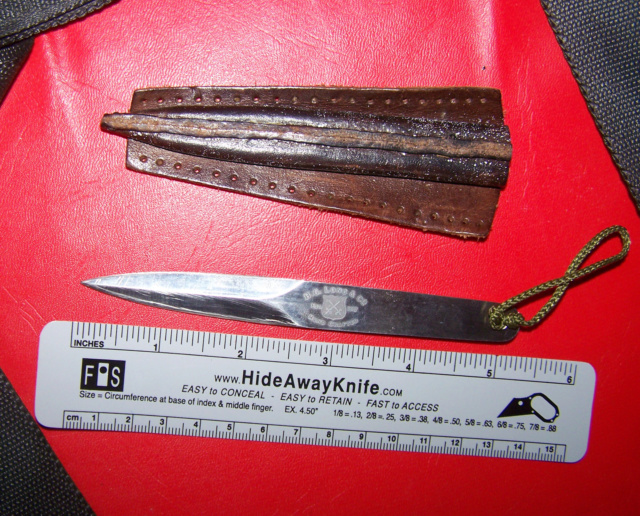
[SOE Lapel Dagger with sheath,, from the collection of Den]
a] As the enemy security policeman reached for your papers, or, to seize you, slash rapidly across the back of his hand in a forward/back series. This induces shock and blood loss, allowing escape.
b] If he was wearing gloves, the face/neck was suggested. (Slashing across the forehead drops a cascade of blood into the eyes, denying vision. Slashing the throat/neck causes great psychological shock, and pursuit is unlikely.
c] If circumstances allow, a quick stab to the thigh, is a good complement to the above slashes.
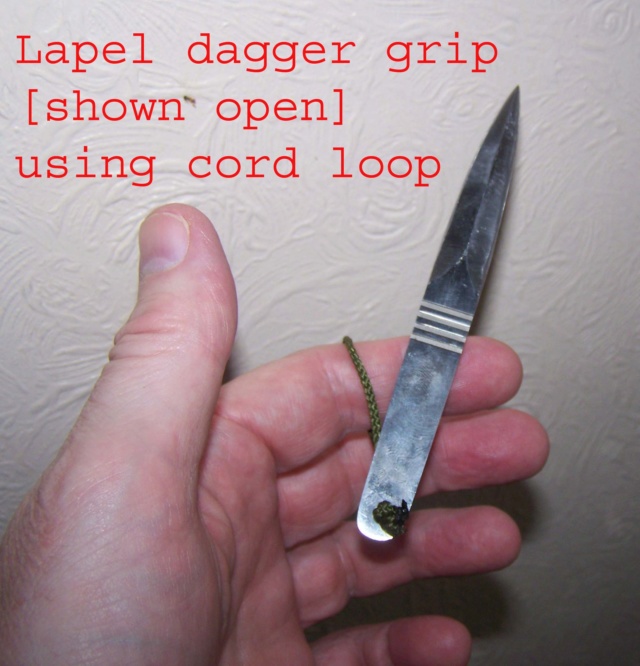
2] SILENT KILLING
The agent, or, reseau leader might have to eliminate traitors, informer’s, or, neutralise sentries. Normally this would be done with the F-S dagger, or, the silent Welrod pistol, but lacking them the Lapel Dagger could be utilised. The thrust-grip, with the blade protruding from between the first two fingers was suggested. Targets included:-
Under the jaw, striking upwards
Into the ear canal
The groove parallel to the spine where it joins the skull
The Subclavian.
3] SUICIDE
An agent captured and facing torture could use the Lapel Dagger for suicide. Normally the L-pill was issued but many agents declined them.
Upon capture the agent would be frisked for firearms, handcuffed then thrown into a van. He, or, she could access the blade stab into the subclavian. This was guaranteed to be fatal, with no chance of medical intervention. Alternatively a slash to the femoral and radial arteries would cause massive haemorrhage and would be likely to succeed, but there was a chance of medical revival.
THE MODERN SCENEThumb/Lapel daggers have formed the inspiration for a plethora of post-war edged weapons. Currently renowned French weapons designer Fred Perrin produces some modern copies of the classic wartime weapons, as well as several innovative versions of his own.
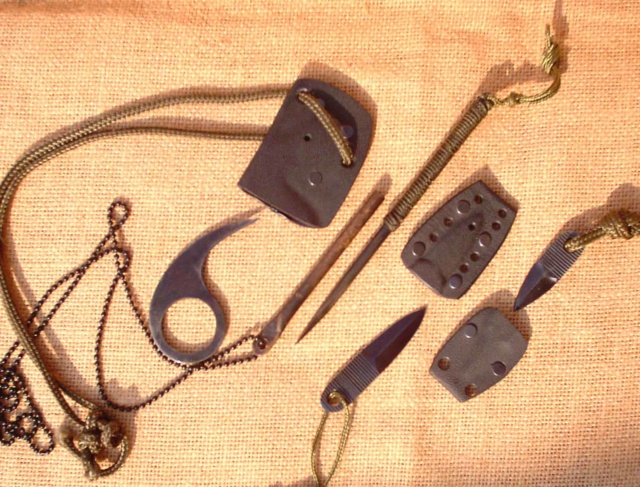 [Perrin designs, from the collection of Den Below is his “killing needle”]
[Perrin designs, from the collection of Den Below is his “killing needle”]
In some way the Hideaway Knife [HAK] can be considered the epitome of the clandestine knife development. With numerous covert-carriage options and accessories this compact blade is a true 24/7 weapon.

CAVEAT EMPTOR
Genuine wartime blades fetch high prices from collectors. Because of this a thriving trade in fake/repro blades has grown up. Before parting with your cash make sure that the knife actually existed during the war, and the example you are considering is a genuine wartime product.
Some good reproductions have been produced, and these are fine, as long as you know you are buying a modern copy, priced accordingly. In fact, some of these repros are themselves quite sought after, and now command high prices in their own right.
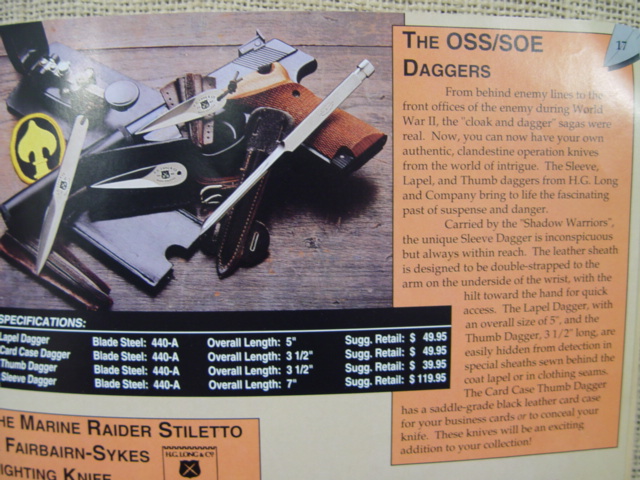 [The HG Long company, which made actual wartime knives, offered these modern repros. Well made, and value for money, they are now rarities themselves]
[The HG Long company, which made actual wartime knives, offered these modern repros. Well made, and value for money, they are now rarities themselves]
References
1 Clandestine Edged Weapons, by Dr William Windrum
2] Secret Agents Handbook [introduction text by Mark Seaman], Lyons Press.
3] All quotes by Colonel Wood from Aston House, SOE Station Xii, by Des Turner.
4] Tiny Terrors, WW-2 Lapel and Thumb Daggers, by Leroy Thompson, Tactical Knives Magazine
5] Service Resume of Lt Colonel W.E. Fairbairn, National Archives, USA.
ACKNOWLEDGEMENTS:
My thanks:-
To the late Terry Haglund, a mine of information on all aspects of edged weapons and the wartime special activities.
To Nick Engelen for assistance with the photos. Nick is currently researching this topic and his results will appear here in the near future
Copyright © Dennis Martin 2007
